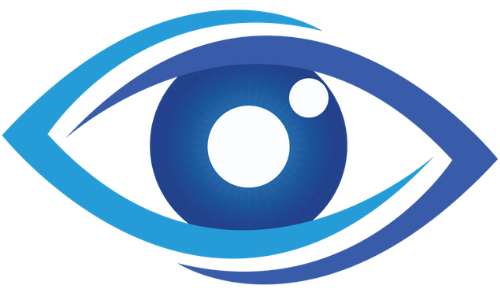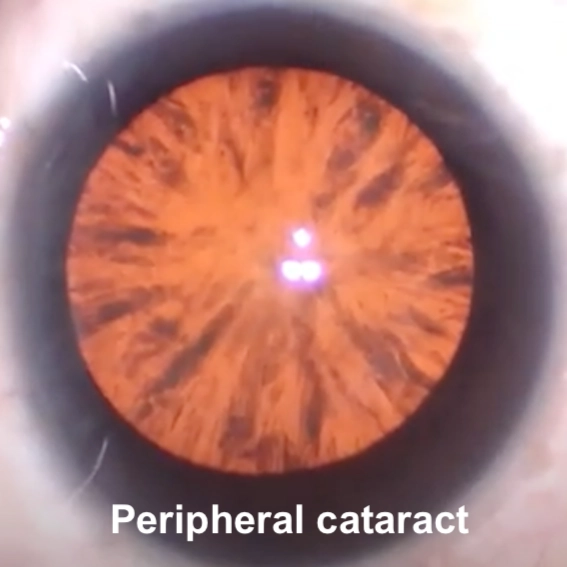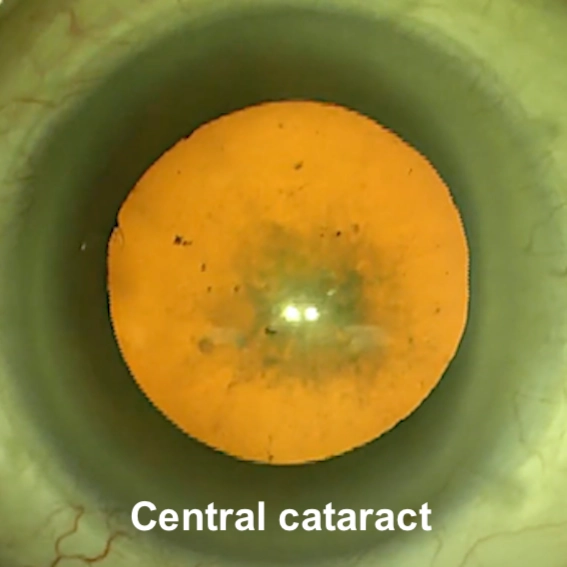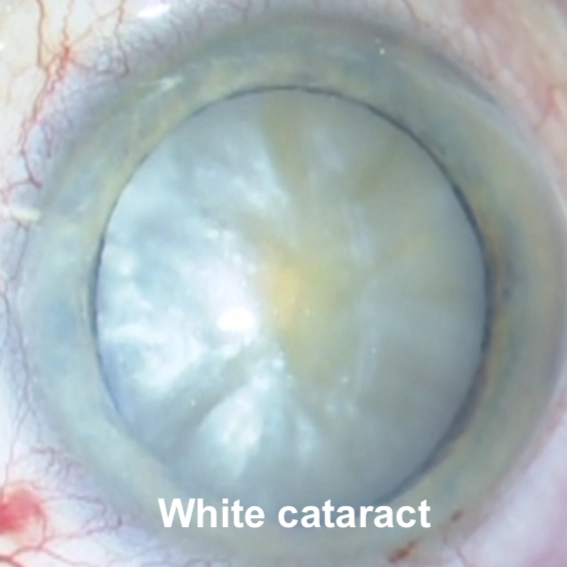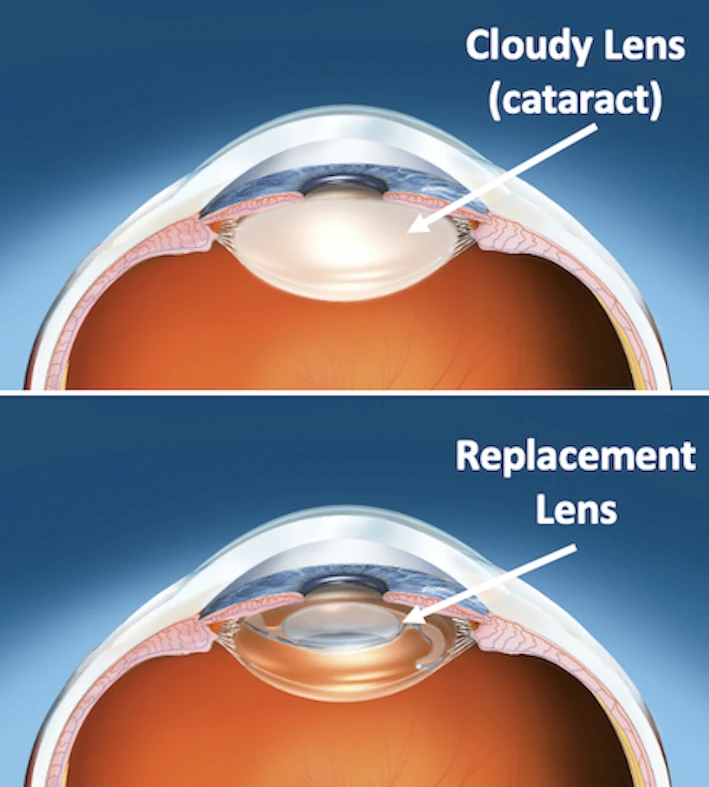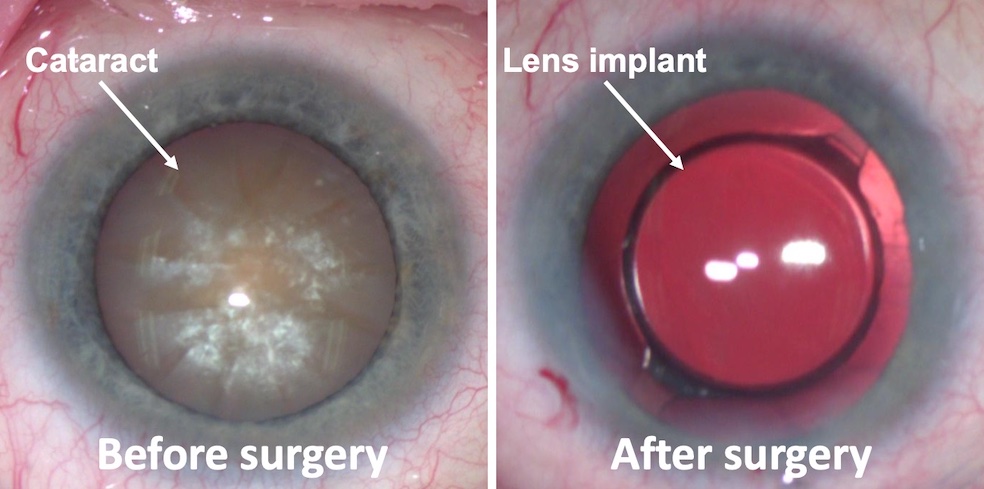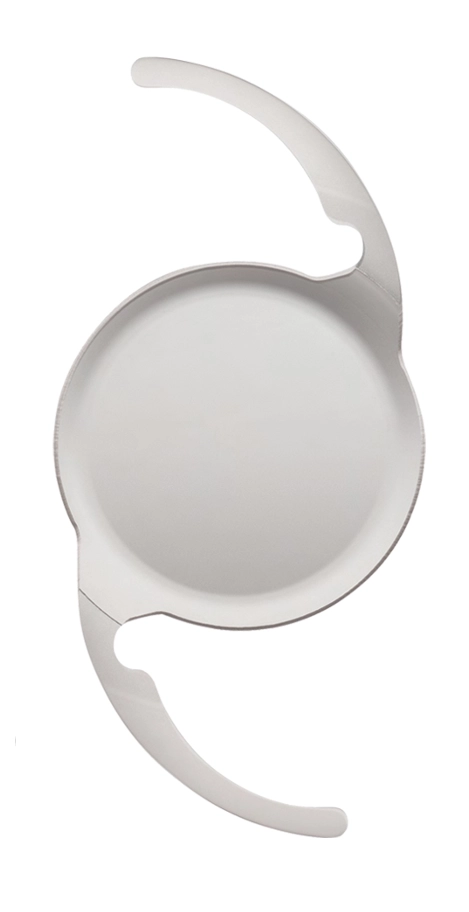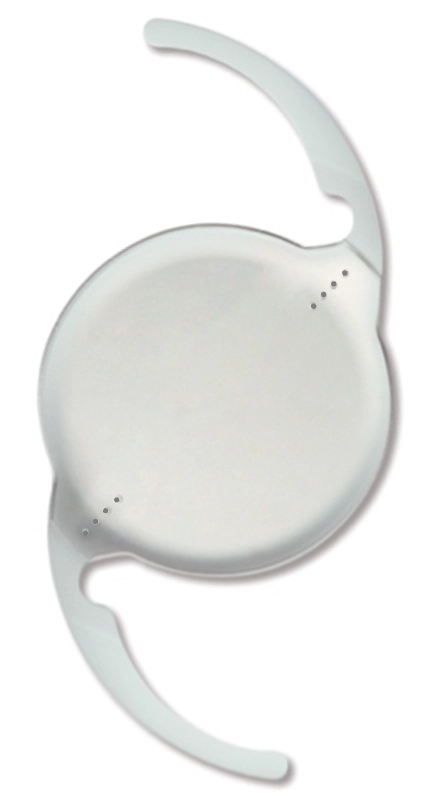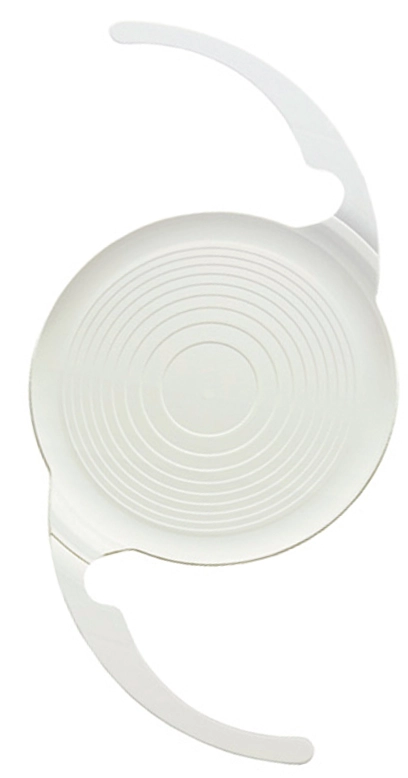A cataract is a clouding of the lens inside the eye. With cataracts, the vision gradually becomes misty or foggy, making it difficult to read or drive (especially at night). For people who have cataracts, seeing through cloudy lenses is a bit like looking through a frosty or fogged-up window.
Cataract
What is a cataract?
Cataracts usually build slowly as we age, and early on they do not interfere with vision. But with time, cataracts will eventually interfere with the clarity of your vision, affecting your daily activities, and at that point, they will need treatment by surgery.
Fortunately, with modern technology, cataract surgery is generally a safe and quick procedure. Mr. Ellabban has operated on thousands of patients with cataracts, and he is experienced in all types of cataract surgery.
Symptoms of cataract
Cataract can cause different symptoms depending on the type and density of the cataract as:
- Cloudy or misty or foggy or dim vision
- Increasing difficulty with vision at night
- Fading or yellowing of colours
- The colours are not looking as vivid
- Seeing “halos” around lights
- Ghosting of images
- Frequent changes in eyeglass or contact lens prescription
Mr Ellabban recommends getting your eyes checked whenever you feel like there is a change in your eyesight or you have any of these symptoms.
How a cataract forms?
The lens, where cataracts form, is behind the iris (the coloured part of your eye). The main function of the lens is to focus light that passes into your eye, producing a sharp image on the retina (back of the eye). As we age, the lens inside the eye becomes less transparent and thicker. The tissue within the lens starts to degrade and clump down, leading to the clouding of small areas within the lens. As the cataract continues to develop, the clouding becomes denser and involves a bigger part of the lens.
A cataract (cloudy lens) can scatter or block the light as it passes through, leading to blurred vision. Cataracts usually develop in both eyes, but one eye may have a cataract more than the other, causing a difference in vision between the eyes.
Risk factors for cataract development
There are some factors that may increase your risk of cataracts, including:
- Diabetes
- Previous eye surgery
- Prolonged use of corticosteroid medications
- Excessive exposure to sunlight
- Smoking
- Drinking excessive amounts of alcohol
- Previous treatment with eye injections
- Systemic diseases such as atopic dermatitis, Myotonic dystrophy ..etc.
How is cataract treated?
When the cataract interferes with your lifestyle or daily activities, it will need treatment. Surgery is the only way to treat cataracts by replacing the cloudy lens with a clear plastic lens. Surgery is mostly done under local anaesthetic with some numbing drops or occasionally with a small volume of anaesthetic injection around your eye.
The surgery often takes between 10-15 minutes while lying flat and then you can go home after the surgery. You will be advised to put some drops after the surgery to help the eye to heal quickly.
If you have any queries about your suitability for private cataract surgery, you can Request a Call Back by filling out the form in the contact section.
Types of replacement lenses
With recent advances in technology, there are different types of lens implants, called Intraocular lenses (IOL). The suitability for each design of lenses depends on multiple factors which will be carefully considered and discussed in detail at your consultation. The decision is customised to the patient’s needs and his eye health. There are 4 main types of lenses:
Extended Depth of Focus (EDOF) IOL
Extended Depth of Focus (EDOF) is a new technology to correct presbyopia and offer an increased level of spectacle independence. EDOF lenses work by creating a single elongated focal point to enhance the “range of vision” or “depth of focus”. They offer distance as well as intermediate vision for more spectacle independence.
Why Choose Mr Ellabban for your Private Cataract Surgery?
- Experience – Mr Ellabban has carried out more than 10,000 cataract surgeries.
- Specially trained – Mr Ellabban is trained to deal with cataracts of different complexity and in challenging situations. He is also trained to deal with cataract surgeries alongside other eye problems.
- Extremely low complication rate – Mr Ellabban complication rates are far below national standards and are regularly audited. Mr Ellabban is also a retinal surgeon, which means he can deal with any complications that may occur during the surgery.
- Cataract surgery personalised to you – Mr Ellabban will discuss all aspects of surgery (type of lens implants, anaesthesia, visual expectations) and plan surgery customised to your needs.
- No need to wait for surgery – Mr Ellabban and his team will plan surgery within 1-2 weeks from your first consultation. You do not need to wait until your vision deteriorates.
- No need to wait for second eye surgery – Mr Ellabban will plan surgery for the second eye within 1 week of the first eye. This means quicker recovery and visual rehabilitation. No need to wait for a long period.
- You can choose your surgery date – making it easier for you to schedule your life.
- Integrated care – the assessment before surgery and aftercare is done by Mr Ellabban. You do not have to meet a new team member each time.
- Choice of anaesthesia – Mr Ellabban performs the majority of cataract procedures using a local anaesthetic (usually numbing drops). He can also provide surgery under general anaesthesia or sedation if that is what you choose.
For further information, check out Mr. Ellabban’s online reviews:
If you have any questions about your suitability for private cataract surgery, you can contact us by filling out the form in the contact section.
Cataract Surgery Improves Quality of Life
Quality of life means the physical, functional, social, and emotional well-being of an individual. Visual impairment due to cataracts can negatively affect the quality of life, leading to difficulties in daily activities, increased depression, social isolation, increased risk of falls and fractures, poorer general health, and increased mortality.
Recent research showed that improved vision after cataract surgery can significantly improve the quality of life in many dimensions, including improved self-confidence in daily activities (such as walking, reading & driving) and enhanced participation in social activities.
Thus, the goal of cataract extraction is not only to improve functional vision but also performance in daily living activities and this is largely due to the effect that poor vision has on the quality of life, general health, social status and mortality rates (link to full article).
Cataract Surgery Reduces the Risk of Dementia
Researchers found that participants who underwent cataract removal surgery had a nearly 30% lower risk of developing dementia and Alzheimer’s disease compared with participants without surgery (link to full article).
“My mother has dementia and she had cataract surgery. Her vision was better the next day and she is more confident walking around the house. Also watching the subtitles on TV is easier as she has hearing difficulty. She is now looking forward to having the second eye surgery.” Daughter of a patient
What to prepare for a private cataract surgery assessment?
- Bring a list of your current medications.
- Bring previous prescription or optician documents, if any.
- List all symptoms you are experiencing.
- List questions to ask your doctor.
Frequently asked questions
Is there any way to prevent cataract?
Cataracts are often a part of the natural ageing process, and there is no medication or specific diet that can prevent the development of cataracts. However, some people may develop it at an earlier age than others, often called secondary cataracts, as in cases of eye trauma, diabetes, and certain diseases.
Is there any way to treat cataract other than surgery?
Surgery is the only way to treat cataracts by replacing the cloudy lens with an artificial clear lens. Stronger glasses or eye drops will not help.
I was told that I have cataracts, but the surgeon advised to wait a while before surgery, why was this?
In some situations, the cataract may be only peripheral and has no or minimal impact on vision or daily activities. Therefore, the specialist may prefer to wait until the cataract becomes denser before offering surgical treatment.
However, if you have a mild cataract that is affecting your lifestyle, then you can discuss with Mr Ellabban about surgery, as needs vary from one person to another.
What is the risk of complications from cataract surgery?
Cataract surgery is one of the most commonly performed surgeries. With modern technology, the risk of complications is small. Like any surgery, there is a small risk of complications, such as:
Common: up to 1 in 30
- Bruising around the eye: common and usually resolves in a few days.
- Temporary rise in eye pressure: usually temporary and resolves in a few days.
- Corneal abrasion: where the surface of the eye gets scratched during surgery. This usually heals in a few days.
- Temporary eye inflammation, or discomfort of the eye that may require further clinic visits or temporary treatment with drops.
Uncommon: up to 1-2 in 100
- Posterior capsule rupture and/or vitreous loss – a split in the thin back wall of the cataract, which can allow communication between the front and back compartments of the eye (risk < 1:100).
- Cystoid macular oedema, which is swelling of the retina, can occur up to 6 weeks to a few months after uneventful It is often treated with anti-inflammatory drops or a steroid injection (risk 1-2 in 100).
- Refractive surprise: unexpected prescription after surgery, needing stronger glasses, or even further corrective surgery (risk <1:100).
- Dry eyes: some patients may experience some dry eye symptoms after the surgery. In most cases, it gets better as time goes on. Rarely, it may require further treatment.
- Glaucoma (high pressure inside the eye) requiring long-term treatment (risk < 1:100).
- Swelling of the cornea (clear window of the eye) requiring long-term treatment or surgery (risk < 1:200)..
- Lens edge effect – some patients notice the edge of the intraocular lens when the pupil is dilated at night. The semi-circular line in the far peripheral vision usually fades with time and no action is required (risk < 1:100).
- Eyelid drooping – usually temporary, very rarely needs further surgery.
- Retained lens matter in the front part of the eye that requires further surgery (risk 1:200).
- Glare or halos from the artificial lens implant: uncommon (risk < 1:100).
- Compromise of contrast sensitivity: may occur if a premium lens is used.
- Other uncommon complications: e.g. pupil shape change, double vision, droopy eyelid.
Very rare: up to 1 in 1000
- Infection inside the eye called endophthalmitis: rare (less than 1:2000).
- Loss of vision that cannot be improved with glasses: rare (less than 1:2000).
- Prolonged inflammation, which could affect the vision in both eyes: rare (less than 1:1000).
- Neuropathic corneal pain. It rarely occurs after cataract surgery (risk 1:1000).
- Retinal problems such as retinal detachment: rare (risk 2:1000).
- Sympathetic ophthalmia: a very rare condition in which surgery in one eye triggers inflammation and sight problems in the other (1:10,000).
Late complications
- Posterior capsular opacification (PCO) – During cataract surgery, the outer membrane of the lens, called the posterior capsule, is retained to support the new lens implant. This membrane can become cloudy months or years after the surgery, called posterior capsular opacification or PCO (common 10-15%). This can be treated by a special type of laser called YAG laser capsulotomy, performed in the eye clinic.
- Dislocation or decentration or clouding of the lens implant requiring further surgery to exchange the lens. May occur months to years after surgery: rare (risk 1:500).
However, some cataracts are more technically challenging than others. This will be discussed in detail during the initial assessment. Being trained for retinal surgery, Mr Ellabban can deal with all types of challenging cataract surgeries and intraoperative complications.
Will I feel any pain during the suregry?
The eye will be numbed using anaesthetic drops or occasionally a small injection around the eye, therefore, you should not feel any pain.
Will I be put to sleep during the surgery?
The surgery is usually performed with the aid of numbing drops or, occasionally, a small injection around the eye, so you should not feel any pain.
In very special circumstances, the choice of general anaesthesia is taken, usually as per patient request or if the surgeon finds this is the best for you. This decision will be discussed in detail before the surgery.
How long the surgery takes?
In most situations, the surgery takes about 10–15 minutes. In some cases, the surgery may be prolonged, but as you will be awake during the surgery, Mr Ellabban will be able to advise you.
What is the required care after surgery?
You will be advised to use some drops, commonly antibiotic drops for 1 week and ant-inflammatory drops for 3-4 weeks. You are advised to put the medications as you were instructed for safe recovery.
When will I notice an improvement in my vision?
Most people notice an improvement in their clarity of vision in the first few days after the surgery, which usually gets better over time.
When to seek advice after the surgery?
Mr Ellabban will advise you if any follow-up appointment is required. After the surgery, you should seek advice if you feel:
- Your vision has become misty or blurry.
- You see halos around light.
- You feel your vision has deteriorated.
- You feel your eye is aching or sore.
Do I need to wear glasses after cataract surgery?
During cataract surgery, Mr Ellabban will put an artificial lens implant inside the eye. Mr Ellabban will arrange a measurement for the lens implant prescription before the surgery using the latest technology, which has a very high degree of accuracy. The standard surgery with monofocal or toric lens implants often aims to correct vision for distance. You will need glasses for reading mainly, although you may still need glasses for fine focusing at a distance.
Some types of lens implants, called multifocal lenses, can correct vision for both distance and near, so that you are largely spectacle-independent.
Mr Ellabban will discuss these options with you before the surgery to satisfy your needs and make a personalised plan for you.
How should I sleep after the surgery?
When can I go swimming?
When can I travel by plane after the surgery?
Can I bend down after the surgery?
Can a cataract come back after surgery?
If this happens, you will notice a gradual reduction in your vision and glare. Posterior capsular opacification can occur at any time after cataract surgery, from a few months to years. It can cause the vision to be blurry, but it does not damage the eye in any way.
